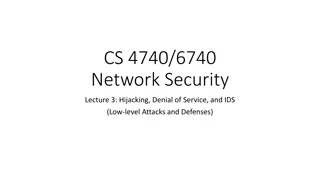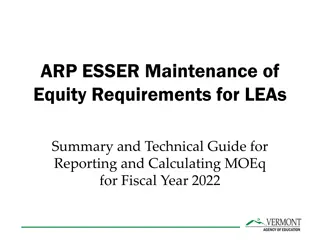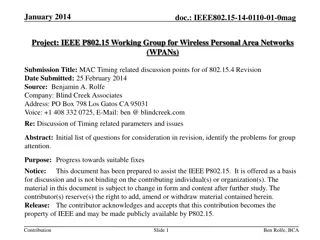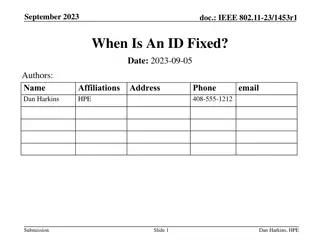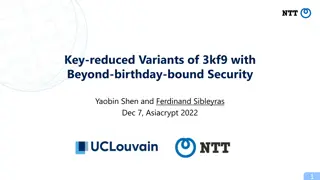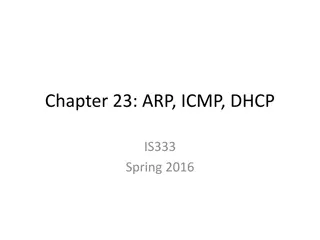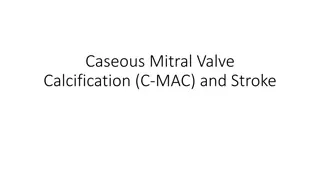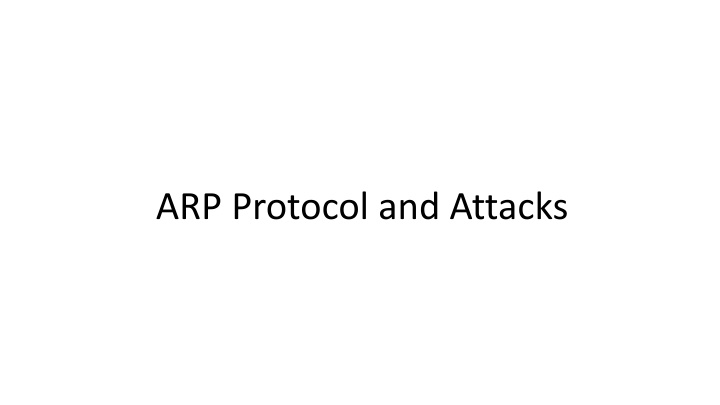
ARP Protocol and Network Interface Basics
Explore the fundamentals of ARP protocol, Ethernet frames, MAC headers, NICs, virtual NICs, promiscuous mode, MAC address randomization, and privacy in this informative content. Learn about ARP cache poisoning attacks and the significance of MAC address resolution in LAN communication.
Download Presentation

Please find below an Image/Link to download the presentation.
The content on the website is provided AS IS for your information and personal use only. It may not be sold, licensed, or shared on other websites without obtaining consent from the author. If you encounter any issues during the download, it is possible that the publisher has removed the file from their server.
You are allowed to download the files provided on this website for personal or commercial use, subject to the condition that they are used lawfully. All files are the property of their respective owners.
The content on the website is provided AS IS for your information and personal use only. It may not be sold, licensed, or shared on other websites without obtaining consent from the author.
E N D
Presentation Transcript
Outline Network Interface Ethernet frame and MAC header ARP protocol ARP cache poisoning attack
Network Interface Card (NIC) Physical or logical link between computer and network Each NIC has a hardware address: MAC address
Packet Flow Network Interface Card
Examples of Virtual NIC Loopback Interface Dummy Interface (similar to loopback, but with its own IP)
Promiscuous Mode Ethernet is a broadcast medium NIC check destination MAC address mine: accept the frame not mine: discard it Enable promiscuous mode Will not check destination MAC Take in all the packets on the local network Useful for packet sniffing
The ARP Protocol Communication on LAN Need to use MAC address But we only know the IP address ARP: Address Resolution Protocol Find MAC from IP
Send ARP Request: Example 1 ping 10.9.0.6 from 10.9.0.5
Send ARP Request: Example 2 ping 10.0.2.15 from 10.0.2.4
Questions Different behaviors of the following commands 1. ping 10.9.0.6 (existing, on LAN) 2. ping 10.9.0.99 (non-existing, on LAN) 3. ping 1.2.3.4 (non-existing, not on LAN) 4. ping 8.8.8.8 (existing, on the Internet)
ARP Cache Avoid sending too many ARP requests ARP caches received information empty cache
ARP Cache Poisoning Spoof ARP Messages Request Reply Gratuitous message Spoofed message might be cached by the victim Which type of message will be cached depends on OS implementation
Constructing ARP Message Construct ARP packet Fields of ARP and Ether Class
Spoof ARP Request/Reply: Code Skeleton victim: 10.9.0.5 goal: map 10.9.0.99 to aa:bb:cc:dd:ee:ff
Spoofing Gratuitous Message Special type of ARP message Source IP = Destination IP Destination MAC = broadcast address (ff:ff:ff:ff:ff:ff)
Use ARP Cache Poisoning to Redirect Packets Poison A s ARP cache, so B s IP is mapped to M s MAC. Poison B s ARP cache, so A s IP is mapped to M s MAC. Machine A Machine B
Forward Packets without Modification Enable/Disable IP Forwarding sysctl net.ipv4.ip_forward=1 sysctl net.ipv4.ip_forward=0
Demo With IP forwarding on
MITM Step 1: Intercept Packets Disable IP Forwarding sysctl net.ipv4.ip_forward=0 How to Get the packet on M?
MITM Step 2: Get the Intercepted Packets Question: which filter should we use, f1 or f2?
Question Disclaimer: this is a fiction! In the 2020 State of Union address, President Trump said the following: "In 2019, Russian hackers launched many ARP cache-poisoning attacks from Russia against the computer networks inside the White House, but, as I can proudly tell you, under my leadership, my staff has successfully defeated all of these attacks ." Then he paused, looking at the audience, waiting for applause. Do you applaud or not?





